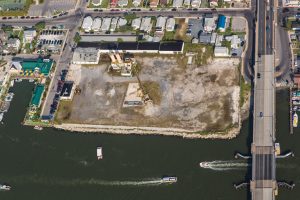
OCEAN CITY — The downtown bayside skyline could get another facelift in the future with a new hotel and restaurant complex on the site of the old Cropper concrete plant, but it will require a rezoning of the historic property.
While there are many details yet to work out, the Planning and Zoning Commission on Tuesday gave tacit approval to a zoning change for the historic George Burt Cropper concrete plant along the bay just north of the Route 50 Bridge and south of 1st Street. Attorney Joe Moore, representing Ropewalk Bel Air Properties LLC, which has a contract to purchase the property and is in the midst of a due diligence period, presented an informal request for a zoning change of the property to Inlet-1, or I-1, a fairly unique zoning designation reserved for a handful of properties along the downtown waterfront.
Moore told resort planners the conceptual plan for the redevelopment includes a mixed-use facility including another location for the popular Ropewalk restaurant along with a hotel situated on the north end of the property. Moore said the site, which is situated prominently along the main entrance to the resort at Route 50, might be the largest undeveloped commercial property in the resort.
“It’s about four acres,” he said. “It may be the largest commercial property, certainly downtown but maybe the whole town.”
For decades, the site was home to the Cropper concrete plant and zoned M-1 manufacturing, a bit of a zoning aberration in an area that has flourished with commercial and residential redevelopment. Moore said the prospective owners are seeking the I-1 zoning designation, which if approved would allow them to move forward with the restaurant and hotel redevelopment plan for the site.
The I-1 zoning designation allows for a wide variety of commercial uses including, of course, a restaurant and hotel. When asked if a marine district designation for the site would be more appropriate, Moore said the property’s juxtaposition to the bridge would make developing a waterfront marina-type project similar to those on the south side of the bridge more challenging.
“We’re not capable of fitting the purpose of the downtown marine district that is so prevalent south of the bridge,” he said. “We couldn’t get a commercial slip if we tried because of the proximity to the bridge and the currents through there. It’s just not a good site for a marina.”
In 2007, the previous property owners gained site plan approval for a 94-unit mixed-use residential project including 54 townhouses and 40 condominiums along with some other amenities including an eventual wrap-around boardwalk on the historic property. The property has since changed hands again and the original site plan approval has been extended at least one other time. With a contract in hand pending the requisite due diligence period, the Ropewalk group is seeking to expedite the requested zoning change in order to meet certain contractual deadlines.
Complicating the issue somewhat is the State Highway Association (SHA) plan to eventually replace the Route 50 bridge, although that could still be decades away. After a considerable review and public hearing process, the preferred alternative is an entirely new draw span immediately north of the existing bridge, which would enter the resort somewhere in the vicinity of the old concrete plant property.
“The favored alternative would take a portion of the south of the property,” he said. “Our intention is to build the hotel as far north as possible. We wouldn’t want the hotel chock-a-block to the new bridge. State Highway is being rather vague. This could be long in the future.”
Cognizant of the future bridge plans, Moore said the property owner intends to avoid developing areas that ultimately might be acquired, or even “taken,” by SHA for a new Route 50 span.
“We are not going to get into any area where the proposed bridge might come through,” he said. “If they come in 30 years from now and want to buy the property, now that’s a different story. We want to stay away. That’s why we want to get as far north as possible, even because of the bridge noise.”
Typically, zoning change requests are based on one of two factors, or both, including a mistake in the original zoning or a change in the character of the neighborhood. Moore said the latter certainly applies for the property in question.
“The change in the neighborhood is obvious,” he said. “It was a concrete plant.”
Planning Commission Chair Pam Buckley agreed however the property is redeveloped, the old M-1 manufacturing designation was no longer appropriate.
“We certainly don’t feel the need for manufacturing in the downtown area,” she said.
Moore further said the original site plan included plans for public-access wrap-around boardwalk along the bayfront and the prospective owners had every intention of honoring that.
“The goal is to make a restaurant row down there,” he said. “From the Lazy Lizard to the Angler and M.R. Ducks, it could be a pedestrian-friendly destination. We’re excited about it.”
The Planning Commission gave tacit approval for the requested zoning change and instructed staff to begin working on the details of the project. There will be required public hearings on the zoning change at the Planning Commission level and the Mayor and Council will ultimately hold sway over the approval. Moore said there was a fairly tight timetable because of the due diligence period with the contract, which is why he was presenting the conceptual plan to resort planners.
“My intent is to have a favorable recommendation from the staff to you all, and ultimately a favorable recommendation from you to the Mayor and Council,” he said.

